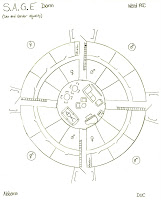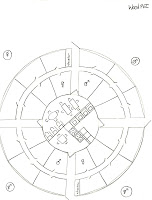This competition was extremely close and both teams did an excellent job, given the level of familiarity they had with design. I could really tell that the students had been paying attention to our discussions of the relationship between the construction of space and different issues pertaining to gender, including the history of identity politics, key issues in feminist ideology, and emphasizing access through design.
The two submissions were in some ways very similar and in other ways quite divergent, highlighting the differences between different versions of feminist thought.
SAGE (Sex and Gender Equality) submitted designs for a residence hall focused on (you guessed it) equality and choice-based feminism. While some "feminist" buildings previously adopted a womb-like structure to counteract the prevalence of phallic architectural objects, SAGE adopted a 2-story circular structure symbolizing unity. The building has four entrances, none of which is more dominant than the others. The group expressed their belief in
intersectionality. They explained this as an idea that emphasizes the shared need for access among all people (rather than the more commonly-held belief in the intersectional nature of identity as having the potential to compound oppression)
Outside the dorm, a communal garden creates extended semi-private space for the residents, where they can lounge or plant flowers and vegetables. Upon entering the building from any of the doors, residents are led straight into the central common areas, facilitating the flow and circulation of people through both public and private space.
On each floor, a central communal location invites students to share space while studying, cooking, or doing laundry. However, even in these public spaces, students have the choice of using more open, public study areas and more private, cubicle-like spaces. This also provides a space for late-night studiers who do not want to disturb their roommates. The halls are divided to allow for students who wish to live in single-sex or co-ed spaces, and there are both double and single rooms. Inside of each room, students may decide on the location of their furniture, because, after all, choice is paramount to SAGE's version of feminism.
SAGE 1st floor:

SAGE 2nd floor:
 Friedan Hall
Friedan Hall, in contrast, emphasizes the view that feminism is about equality that is accompanied by diversity. Here, community and interaction are emphasized over choice through strategies that we may call
architectural determinism. All rooms are doubles, encouraging intermingling among students from different backgrounds. Like SAGE, students have the option of living in single-sex or co-ed spaces, with the vast majority of the space consisting of two perpendicular halls that are each gender segregated. The group clarified, however, that the process of applying to live in the dorm would require students to write an essay that explained their commitment to justice not only related to gender, but also queer, international, and other identities. Trans people, for instance, are allowed to live anywhere in the building (with roommate consent), which is not something, the group argues, could happen if there are single rooms. There are both male and female bathrooms in all of the co-ed spaces, within which there are single-stall bathroom and shower spaces. The group clarified that while single-user restrooms were a potential solution, that the number of students in the dorm necessitated a greater number of toilets and showers. Likewise, because the group's approach to feminism is one that encourages interaction between different kinds of people, the more public restroom style was appropriate.
Friedan Hall consists of four towers connected by glass bridges. In the middle of the towers lies a two-floor structure with public spaces inside (a cafe downstairs and study space upstairs). In the spaces between the towers, there is a courtyard with trees and benches. This courtyard is private in the sense that you must enter the dorm to visit it, but serves as an additional communal space for residents.
The first-floor communal space is a cafe, which will be decorated with posters about feminist history. It will also feature a wall where students can write personal messages and make the space theirs. The second floor includes a central lounge space, as well as individual study spaces scattered throughout the quadrants. In each corner of the building lies an essential space, such as laundry, kitchen, or study facilities. This is one of the most interesting parts of Friedan Hall's design: students, by necessity, must enter the living quadrants of other students, facilitating interaction even when they elect not to enter the designated public spaces, such as the cafe.
Friedan Hall 1st floor:

Friedan Hall 2nd floor:

Both groups used very similar forms in their designs, which perhaps points us toward a new feminist design aesthetic. In both residential halls, each floor was divided into four parts, with each providing a different living environment. Also, both dorms provided the choice of living in coed or single-sex halls (though only Friedan Hall specifically mentioned provisions for trans students). Finally, both dorms opted for neutrally-coded spaces. SAGE rejected both the womb and the phallus as forms. Friedan Hall adopted color-coded hallways that did not use traditionally gendered colors, like blue and pink, as a way of indicating their inclusivity.
Where the groups differed primarily was in their endorsements of feminist thought. This translated directly into the designs. SAGE emphasizes equality and the idea that choice and equal opportunity should override differences. Friedan Hall, in contrast, emphasizes equality through respect for and the cultivation of diversity. In a very direct way, this changed the strategies each team used:
Rooms:
SAGE: gave the choice of either single or double rooms, emphasizing that the choice of private space is a necessary feminist goal.
Friedan Hall: argued that allowing people to live in single rooms does not promote understanding and diversity, and so all students must share doubles. For example, they cited the fact that given the choice of single rooms, trans students may opt to live alone instead of with a roommate who may or may not accept them. Friedan Hall plans to use a questionnaire process to ensure that all students living in the dorm are welcoming of many expressions of gender diversity. This is interesting to think about, because the lack of choice also poses risks to students who may end up living with a roommate who is less tolerant than they believe themselves to be.
Communal Spaces:
SAGE: Communal space is centralized, with the kitchen and laundry room, as well as study spaces, in the center of the building. This is based on their equality-focused approach.
Friedan Hall: Although there is centralized communal space, the distribution of necessary facilities in the wings of the building also forces student interaction, making private living spaces in part semi-private. This is based on their approach to promoting interaction and diversity.
Privacy:
SAGE: provided choice and options for privacy in both public and private spaces (including study spaces and bathrooms)
Friedan Hall: made everything open to facilitate interaction, including making bathrooms shared.
Location:
SAGE: Centrally located (taking the place of Dobbs Hall)
Friedan Hall: In a more traditional freshman dorm space (taking the place of McTrimble at the top of frat row).
Both groups could have improved by thinking about the materials of their buildings and the relationship between the inside and outside of the dorm as public and private space. For example, what is the facade made of and how does it reflect what is inside? Can outsiders see in? Is there a reason to place the public spaces at the center of the building, shielded from the outside?
Stay tuned for the final decision later today!













